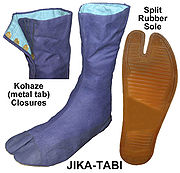
Jika-tabi
Encyclopedia

Footwear
Footwear consists of garments worn on the feet, for fashion, protection against the environment, and adornment. Being barefoot is commonly associated with poverty, but some cultures chose not to wear footwear at least in some situations....
worn in Japan
Japan
Japan is an island nation in East Asia. Located in the Pacific Ocean, it lies to the east of the Sea of Japan, China, North Korea, South Korea and Russia, stretching from the Sea of Okhotsk in the north to the East China Sea and Taiwan in the south...
. It was invented in the 20th century.
Also known (outside Japan) as "tabi boots", they are modelled on tabi, traditional split-toe Japan
Japan
Japan is an island nation in East Asia. Located in the Pacific Ocean, it lies to the east of the Sea of Japan, China, North Korea, South Korea and Russia, stretching from the Sea of Okhotsk in the north to the East China Sea and Taiwan in the south...
ese socks. Like other tabi, jika-tabi have a divided toe area so that they can in theory be worn with slip-on thonged footwear, but they are heavy-duty, and resemble boot
Boot
A boot is a type of footwear but they are not shoes. Most boots mainly cover the foot and the ankle and extend up the leg, sometimes as far as the knee or even the hip. Most boots have a heel that is clearly distinguishable from the rest of the sole, even if the two are made of one piece....
s.
Shojiro Ishibashi, the founder of the major tire company Bridgestone Corporation
Bridgestone
The is a multinational rubber conglomerate founded in 1931 by in the city of Kurume, Fukuoka, Japan. The name Bridgestone comes from a calque translation and transposition of ishibashi, meaning "stone bridge" in Japanese....
, is credited with their invention.
One disadvantage of jika-tabi is that they provide no real protection to the foot against falling objects or protruding sharp objects.
In Japan
Being made of heavy, tough material and often having rubber soles, jika-tabi are often used by construction workers, farmers and gardeners, rickshaw-pullers, and other workmen.Though slowly being replaced by steel-toed, rigid-sole shoes in some industries, many workers prefer them for the softness of their soles. This gives wearers tactile contact with the ground, and the concomitant gripping ability lets them use their feet more agilely than rigid-soled shoes allow. This is useful for workers who traverse girders on construction sites and need to be sure what is under their feet. Carpenters and gardeners wearing these boots can, if they wish, use their feet as an extra pair of hands, for example to hold objects in place. There is also a line of knee-high all-rubber jika-tabi that is used by workers in rice fields and/or wet and muddy environments.
In more recent years, jika-tabi manufacturers, like Marugo and Rikio have introduced the "steel toe" and "hard resin" versions which are approved by the Japan Occupational Safety and Health Resource Center (JOSHRC).
In other countries
Outside Japan, where they are available from online and martial-arts shops, jika-tabi are appreciated by practitioners of martial artsMartial arts
Martial arts are extensive systems of codified practices and traditions of combat, practiced for a variety of reasons, including self-defense, competition, physical health and fitness, as well as mental and spiritual development....
in which traditional clothes are used. Other people also like wearing them for certain kinds of exercise, specifically trail-running
Cross country running
Cross country running is a sport in which people run a race on open-air courses over natural terrain. The course, typically long, may include surfaces of grass and earth, pass through woodlands and open country, and include hills, flat ground and sometimes gravel road...
, walking
Walking
Walking is one of the main gaits of locomotion among legged animals, and is typically slower than running and other gaits. Walking is defined by an 'inverted pendulum' gait in which the body vaults over the stiff limb or limbs with each step...
, and climbing
Climbing
Climbing is the activity of using one's hands and feet to ascend a steep object. It is done both for recreation and professionally, as part of activities such as maintenance of a structure, or military operations.Climbing activities include:* Bouldering: Ascending boulders or small...
.

